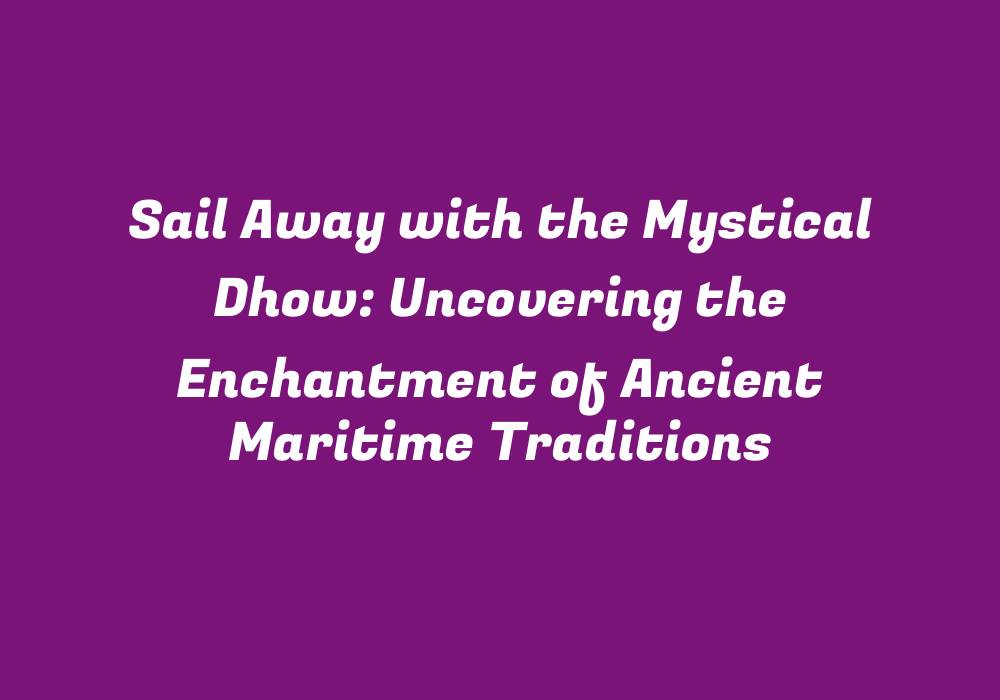Sail Away with the Mystical Dhow: Uncovering the Enchantment of Ancient Maritime Traditions
Introduction
The dhow, an ancient sailing vessel that originated in the Arab world, has left an indelible mark on maritime history. Its elegant design and rich heritage have made it a symbol of mystical traditions across various cultures for centuries.
In this article, we will explore the captivating origins, distinct features, and the significance of dhows in trade, warfare, and cultural exchanges. Additionally, we delve into their role as symbols of unity among diverse communities and how they continue to influence modern maritime practices.
The Origin and Evolution of Dhow Design
Dhows first emerged in the 1st century AD along the eastern coastline of Africa, encompassing modern-day countries such as Somalia, Tanzania, Mozambique, and Kenya. It is believed that the original design came from a need for swift and reliable transportation along the coastal waters to facilitate trade between neighboring regions.
As dhows gained popularity, they evolved in response to new needs and challenges presented by various cultures across Africa, Asia, and beyond. The vessels soon became essential in linking distant lands through trade and maritime exploration, making them an iconic symbol of interconnectedness and globalization.
Distinct Features and Functionality
The dhow’s design showcases a number of unique characteristics that distinguish it from other traditional vessels. Firstly, its slender hull allows for easy maneuverability in shallow waters, making it ideal for navigating through coastal areas. Moreover, the vessel features multiple masts, which enable it to carry large sails that can effectively harness wind power.
The dhow’s traditional sailing rig is designed to maximize efficiency while minimizing reliance on external sources of energy. It also showcases remarkable seafaring capabilities due to its ability to withstand harsh ocean conditions, making it a versatile vessel for long-distance journeys.
Dhow’s Role in Trade and Warfare
Throughout history, the dhow has been extensively used in trade and warfare, enabling economic expansion and territorial conquests across various cultures. As a primary means of transporting valuable goods such as spices, textiles, and precious metals, the vessel played a significant role in connecting Africa, Asia, and Europe.
In addition to its role in trade, dhows were often employed for military purposes. Their ability to carry large crews and weapons made them an ideal platform for conducting naval warfare, especially during conflicts between rival powers or conquests of new territories.
Dhow’s Influence on Cultural Diversity
Throughout its history, the dhow has served as a symbol of unity among diverse communities. By facilitating cross-cultural interactions and trade between countries that would otherwise remain isolated, it fostered the exchange of knowledge, customs, and traditions across various cultures.
One notable example is how the Swahili culture emerged along Africa’s east coast as a result of Arab, Indian, Persian, and African influences. This fusion of cultures is evident in the language, architecture, and culinary arts prevalent in this region today. The dhow played a pivotal role in facilitating these exchanges, creating an environment where people from different backgrounds could coexist harmoniously.
Dhow’s Legacy and Continued Influence
Despite the advent of modern shipping technologies and improved maritime capabilities, dhows still hold a significant place in contemporary maritime culture. They can be found across the African, Arabian, and Indian Ocean regions, serving as vital modes of transportation for both trade and tourism.
Moreover, the dhow has inspired the design and construction of modern leisure vessels like catamarans and yachts, demonstrating its continued influence on global maritime practices. Its unique blend of beauty, functionality, and cultural significance ensure that the mystical dhow will continue to captivate future generations for centuries to come.
Conclusion
The ancient dhow’s timeless design and rich history have not only made it an enduring symbol of maritime tradition, but also a powerful testament to the importance of cross-cultural exchange and collaboration. From its humble beginnings as a coastal transport vessel to its role in facilitating global trade and warfare, the mystical dhow has shaped human civilization and left an indelible mark on the world’s maritime history.
As we continue to explore the depths of our oceans and navigate through uncharted territories, it is important to remember the legacy of this captivating vessel that once sailed the waves, connecting distant lands in a shared pursuit of knowledge, progress, and harmony.
